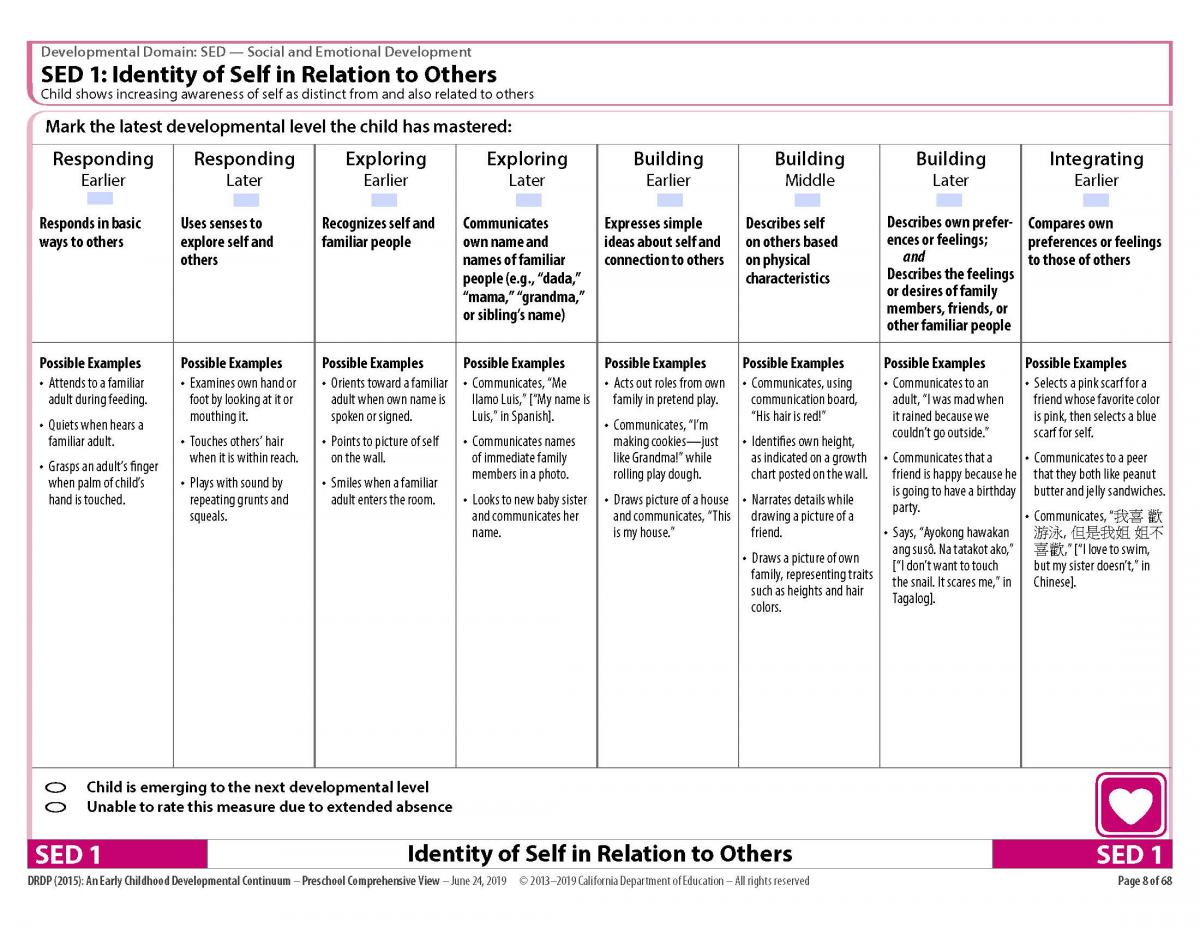Return to DRDP Measure Video Examples
Definition: Child shows increasing awareness of self as distinct from and also related to others
 View examples of the developmental levels for SED Measure 1 below: Responding Earlier, Responding Later, Exploring Earlier, Exploring Later, Building Earlier, Building Middle, Building Later, Integrating Earlier
View examples of the developmental levels for SED Measure 1 below: Responding Earlier, Responding Later, Exploring Earlier, Exploring Later, Building Earlier, Building Middle, Building Later, Integrating Earlier
Note: For young children, learning is an integrated experience. The examples below may include multiple areas of learning and development.
Responding EarlierResponds in basic ways to others Possible Examples - Attends to a familiar adult during feeding.
- Quiets when hears a familiar adult.
- Grasps an adult’s finger when palm of child’s hand is touched.
| |
Responding LaterUses senses to explore self and others Possible Examples - Examines own hand or foot by looking at it or mouthing it.
- Touches others’ hair when it is within reach.
- Plays with sound by repeating grunts and squeals.
| Source: California Department of Social Services. 2016. |
Exploring EarlierRecognizes self and
familiar people Possible Examples - Orients toward a familiar adult when own name is spoken or signed.
- Points to picture of self on the wall.
- Smiles when a familiar adult enters the room.
| |
Exploring LaterCommunicates own name and names of familiar people (e.g., “dada,” “mama,” “grandma,” or sibling’s name) Possible Examples - Communicates, “Me llamo Luis,” [“My name is Luis,” in Spanish].
- Communicates names of immediate family members in a photo.
- Looks to new baby sister and communicates her name.
| |
Building EarlierExpresses simple ideas about self and connection to others Possible Examples - Acts out roles from own family in pretend play.
- Communicates, “I’m making cookies—just like Grandma!” while rolling play dough.
- Draws picture of a house and communicates, “This is my house.”
| |
Building MiddleDescribes self on others based on physical
characteristics Possible Examples - Communicates, using communication board, “His hair is red!”
- Identifies own height, as indicated on a growth chart posted on the wall.
- Narrates details while drawing a picture of a friend.
- Draws a picture of own family, representing traits such as heights and hair colors.
| |
Building LaterDescribes own preferences or feelings;
and
Describes the feelings or desires of family members, friends, or
other familiar people Possible Examples - Communicates to an adult, “I was mad when it rained because we couldn’t go outside.”
- Communicates that a friend is happy because he is going to have a birthday party.
- Says, “Ayokong hawakan ang susô. Na tatakot ako,” [“I don’t want to touch the snail. It scares me,” in Tagalog].
| |
Integrating EarlierCompares own preferences or feelings to those of others Possible Examples - Selects a pink scarf for a friend whose favorite color is pink, then selects a blue scarf for self.
- Communicates to a peer that they both like peanut butter and jelly sandwiches.
- Communicates, “我喜 歡 游泳, 但是我姐 姐不 喜歡,” [“I love to swim, but my sister doesn’t,” in Chinese].
| What would your example be? |
Return to DRDP Measure Video Examples
 View examples of the developmental levels for SED Measure 1 below: Responding Earlier, Responding Later, Exploring Earlier, Exploring Later, Building Earlier, Building Middle, Building Later, Integrating Earlier
View examples of the developmental levels for SED Measure 1 below: Responding Earlier, Responding Later, Exploring Earlier, Exploring Later, Building Earlier, Building Middle, Building Later, Integrating Earlier